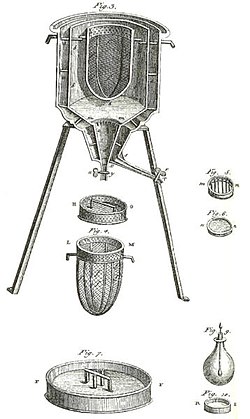Calorimetry is the science of measuring the heat of chemical reactions or physical changes. Calorimetry involves the use of a calorimeter. The word calorimetry is derived from the Latin word calor, meaning heat. Scottish physician and scientist Joseph Black, who was the first to recognize the distinction between heat and temperature, is said to be the founder of calorimetry.[1]
Indirect calorimetry calculates heat that living organisms produce from their production of carbon dioxide and nitrogen waste (frequently ammonia in aquatic organisms, or urea in terrestrial ones), OR from their consumption of oxygen. Lavoisier noted in 1780 that heat production can be predicted from oxygen consumption this way, using multiple regression. The Dynamic Energy Budget theory explains why this procedure is correct. Of course, heat generated by living organisms may also be measured by direct calorimetry, in which the entire organism is placed inside the calorimeter for the measurement.

The specific heat formula is as follows:
where
- q is energy, or heat,
- m is mass,
- c is specific heat capacity,
- ΔT is change in temperature.
Constant-volume calorimetry (Bomb Calorimetry)
Constant-volume calorimetry is calorimetry performed at a constant volume. This involves the use of a constant-volume calorimeter.
No work is performed in constant-volume calorimetry, so the heat measured equals the change in internal energy of the system. The equation for constant-volume calorimetry is (the heat capacity at constant volume is assumed to be constant):
where
- ΔU is change in internal energy,
- ΔT is change in temperature and
- CV is the heat capacity at constant volume.
Since in constant-volume calorimetry the pressure is not kept constant, the heat measured does not represent the enthalpy change.





0 comments:
Post a Comment